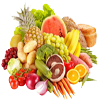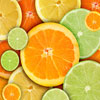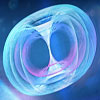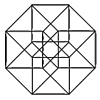Nutritional Concepts
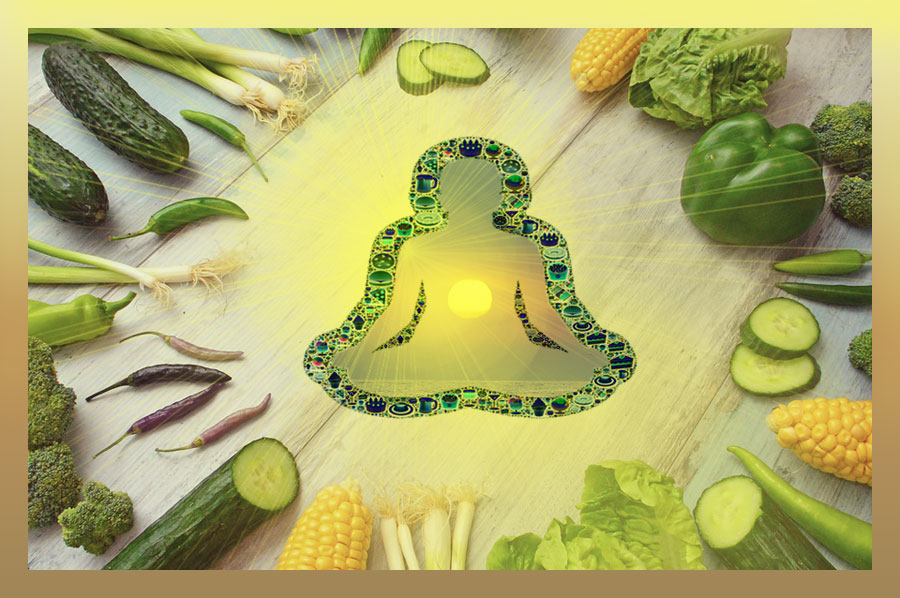 by Max Heindel
by Max Heindel
The first visible state of a human embryo is a small, globulous, pulpy or jelly-like substance, similar to albumen, or the white of an egg. In this pulpy globule various particles of more solid matter appear. These gradually increase in bulk and density until they come in contact with one another. The different points of contact are slowly modified into joints or hinges and thus a distinct framework of solid matter, a skeleton, is gradually formed.
During the formation of this framework the surrounding pulpy matter accumulates and changes in form until at length that degree of organization develops which is known as a fetus. This becomes larger, firmer, and more fully organized up to the time of birth, when the state of infancy begins.
The same process of consolidation which commenced with the first visible stage of existence, still continues. The being passes through the different stages of infancy, childhood, youth, manhood or womanhood, old age, and at last comes to the change that is called death.
Each of these stages is characterized by an increasing degree of hardness and solidity.
There is a gradual increase in density and firmness of the bones, tendons, cartilages, ligaments, tissues, membranes, the coverings and even the very substance of the stomach, liver, lungs, and other organs. The joints become rigid and dry. They begin to crack and grate when they are moved, because the synovial fluid, which oils and softens them, is diminished in quantity and rendered too thick and glutinous to serve that purpose.
The heart, the brain, and the entire muscular system, spinal cord, nerves, eyes, etc., partake of the same consolidating process, growing more and more rigid. Millions upon millions of the minute capillary vessels which ramify and spread like the branches of a tree throughout the entire body, gradually choke up and change into solid fiber, no longer pervious to the blood.
The larger blood vessels, both arteries and veins, indurate, lose their elasticity, grow smaller, and become incapable of carrying the required amount of blood. The fluids of the body thicken and become putrid, loaded with earthy matter. The skin withers and grows wrinkled and dry. The hair falls off for lack of oil. The teeth decay and drop out for lack of gelatin. The motor nerves begin to dry up and the movements of the body become awkward and slow. The senses fail; the circulation of the blood is retarded; it stagnates and congeals in the vessels. More and more the body loses its former powers. Once elastic, healthy, alert, pliable, active and sensitive, it becomes rigid, slow, and insensible. Finally, it dies of old age.
The question now arises, What is the cause of this gradual ossification of the body, bringing rigidity, decrepitude, and death?
From the purely physical standpoint, chemists seem to be unanimous in the opinion that it is principally an increase of phosphate of lime (bone matter), carbonate of lime (common chalk), and sulphate of lime (plaster of Paris), with occasionally a little magnesia and an insignificant amount of other earthy matters.
The only difference between the body of old age and that of childhood is the greater density, toughness and rigidity, caused by the greater proportion of calcareous, earthy matter entering into the composition of the former. The bones of a child are composed of three parts of gelatin to one part of earthy matter. In old age this proportion is reversed. What is the source of this death-dealing accumulation of solid matter?
It seems to be axiomatic that the entire body is nourished by the blood and that everything contained in the body, of whatever nature, has first been in the blood. Analysis shows that the blood holds earthy substances of the same kind as the solidifying agents–and note–the arterial blood contains more earthy matter than the venous blood.
This is highly important. It shows that in every cycle the blood deposits earthy substances. It is therefore the common carrier that chokes up the system. But its supply of earthy matter must be replenished, otherwise it could not continue to do this. Where does it renew its deadly load? There can be but one answer to that question–from the food and drink; there is absolutely no other source.
The food and drink which nourish the body must be, at the same time, the primary source of the calcareous, earthy matter which is deposited by the blood all over the system, causing decrepitude and finally death. To sustain physical life it is necessary that we eat and drink but as there are many kinds of food and drink, it behooves us, in the light of the above facts, to ascertain, if possible, what kinds contain the smallest proportion of destructive matter. If we can find such food we can lengthen our lives and, from a spiritual standpoint, it is desirable to live as long as possible in each dense body, particularly after a start has been made toward the path. So many years are required to educate, through childhood, each body inhabited, until the spirit can at last obtain some control over it, that the longer we can retain a body that has become amenable to the spirit’s promptings, the better. Therefore it is highly important that the pupil partake of such food and drink only as will deposit the least amount of hardening matter and at the same time keep the excretory organs active.
The skin and the urinary system are the saviors of man from an early grave. Were it not that by their means, most of the earthy matter taken with our food is eliminated, no one would live ten years.
It has been estimated that ordinary, undistilled spring water contains carbonate and other compounds of lime to such an extent that the average quantity used each day by one person in the form of tea, coffee, soup, etc., would in forty years be sufficient to form a block of solid chalk or marble the size of a large man. It is also a significant fact that although phosphate of lime is always found in the urine of adults, it is not found in the urine of children, because in them the rapid formation of bone requires that this salt be retained. During the period of gestation there is very little earthy matter in the urine of the mother, as it is used in the building of the fetus. In ordinary circumstances, however, earthy matter is very much in evidence in the urine of adults and to this we owe the fact that physical life reaches even its present length.
Non-distilled water, when taken internally, is man’s worst enemy, but used externally, it becomes his best friend. It keeps the pores of the skin open, induces circulation of the blood and prevents the stagnation which affords the best opportunity for the depositing of the earthy, death-dealing phosphate of lime.
Harvey, who discovered the circulation of the blood, said that health denotes a free circulation and disease is the result of an obstructed circulation of the blood.
The bathtub is a great aid in keeping up the health of the body and should be freely used by the aspirant to the higher life. Perspiration, sensible and insensible, carries more earthy matter out of the body than any other agency. As long as fuel is supplied and the fire kept free from ashes, it will burn. The kidneys are important in carrying away the ashes from the body, but despite the great amount of earthy matter carried away by the urine, enough remains in many cases to form gravel and stone in the bladder, causing untold agony and often death.
Let no one be deceived into thinking that water contains less stone because it has been boiled. The stone that forms on the bottom of the teakettle has been left there by the evaporated water which escaped from the kettle as steam. If the steam were condensed, we should have distilled water, which is an important adjunct in keeping the body young.
There is absolutely no earthy matter in distilled water, nor in rain water, snow nor hail (except what may be gathered by contact with rooftops, etc.), but coffee, tea, or soup made with ordinary water, no matter how long boiled, is not purified of the earthy particles; on the contrary, the longer they are boiled, the more heavily charged with ash they become. Those suffering from urinary diseases should never drink any but distilled water.
It may be said generally of the solid foods we take into our system, that fresh vegetables and ripe fruits contain the greatest proportion of nutritious matter and the least of earthy substances.
As we are writing for the aspirant to the higher life and not for the general public, it may also be said that animal food should be entirely avoided, if possible. No one who kills can go very far along the path of holiness. We do even worse than if we actually killed, for in order to shield ourselves from the personal commission of the act of killing, and still reap its results, we force a fellow being, through economic necessity, to devote his entire time to murder, thereby brutalizing him to such an extent that the law will not allow him to act as a juror in cases of capital crime, because his business has so familiarized him with the taking of life.
The enlightened know the animals to be their younger brothers and that they will be human in the Jupiter Period. We shall then help them as the Angels, who were human in the Moon Period, are now helping us, and for an aspirant to high ideals to kill–either in person or by proxy–is out of the question.
Several very important food products from animals, such as milk, cheese and butter, may be used. These are the results of the processes of life and require no tragedies to convert them into food. Milk, which is an important food for the spiritual student, contains no earthy matter of any consequence and has an influence upon the body possessed by no other food.
During the Moon Period man was fed upon the milk of Nature. Universal food was absorbed by him and the use of milk has a tendency to put him in touch with the Cosmic forces and enable him to heal others.
It is popularly supposed that sugar or any saccharine substance is injurious to the general health, and particularly to the teeth, causing their decay and the resulting toothache. Only under certain circumstances is this true. It is harmful in certain diseases, such as biliousness and dyspepsia, or if held long in the mouth as candy, but if sparingly used during good health and the amount gradually increased as the stomach becomes accustomed to its use, it will be found very nourishing. The health of the plantation worker becomes greatly improved during the sugar-cane harvest time, notwithstanding their increased labor. This is attributed solely to their fondness for the sweet cane-juice. The same may be said of horses, cows, and other animals in those localities, which are all fond of the refuse syrup fed to them. They grow fat in harvest time, their coats becoming sleek and shining. Horses fed on boiled carrots for a few weeks will get a coat like silk, owing to the saccharine juices of that vegetable. Sugar is a nutritious and beneficial article of diet and contains no ash whatever.
Fruits are an ideal diet. They are in fact evolved by the trees to induce animal and man to eat them, so that the seed may be disseminated, as flowers entice bees for a similar purpose.
Fresh fruit contains water of the purest and best kind, capable of permeating the system in a marvelous manner. Grape juice is a particularly wonderful solvent. It thins and stimulates the blood, opening the way into capillaries already dried and choked up–if the process has not gone too far. By a course of unfermented grape-juice treatment, people with sunken eyes, wrinkled skins and poor complexions become plump, ruddy and lively. The increased permeability enables the spirit to manifest more freely and with renewed energy. The following tables, which with the exception of the last column, is taken from the publications of the United States Department of Agriculture, will give the aspirant some idea of the amount it is necessary to eat for different degrees of activity, also the constituents of the various foods named.
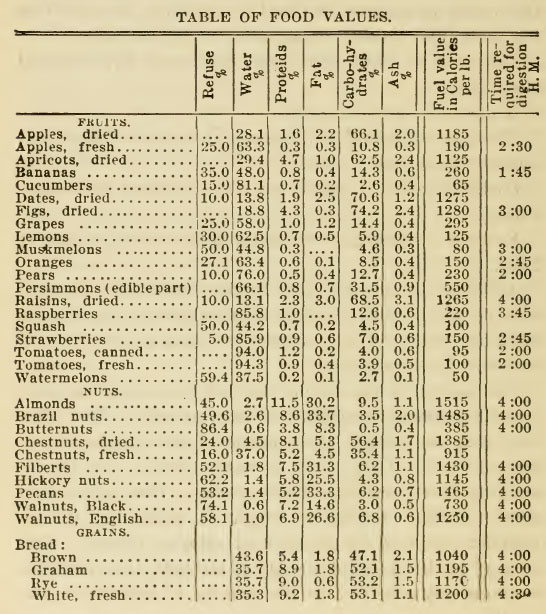
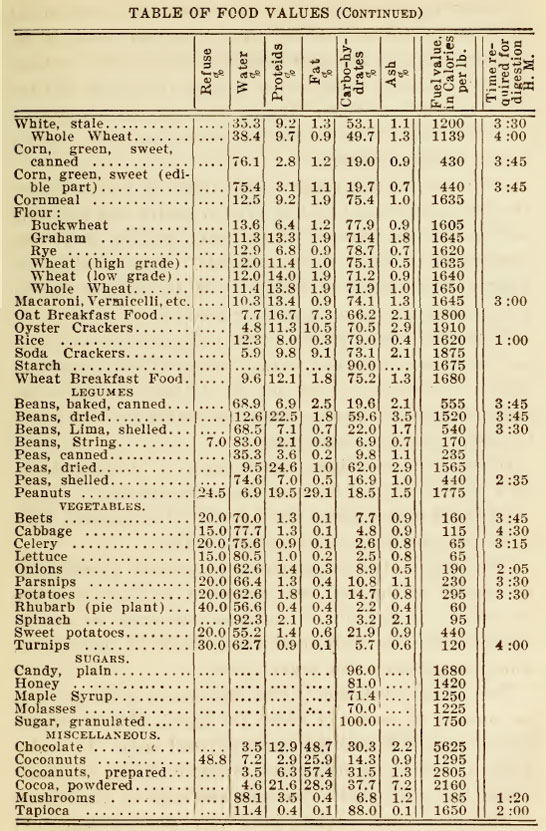 Considering the body from a purely physical standpoint, it is what we might call a chemical furnace, the food being the fuel. The more the body is exercised, the more fuel it requires. It would be foolish for a man to change an ordinary diet which for years had adequately nourished him, and take up a new method without due thought as to which would be the best for serving his purpose. To simply eliminate meats from the ordinary diet of meat-eaters would unquestionably undermine the health of most persons. The only safe way is to experiment and study the matter out first, using due discrimination. No fixed rules can be given, the matter of diet being as individual as any other characteristic. All that can be done is to give the table of food values and describe the general influence of each chemical element, allowing the aspirant to work out his own method.
Considering the body from a purely physical standpoint, it is what we might call a chemical furnace, the food being the fuel. The more the body is exercised, the more fuel it requires. It would be foolish for a man to change an ordinary diet which for years had adequately nourished him, and take up a new method without due thought as to which would be the best for serving his purpose. To simply eliminate meats from the ordinary diet of meat-eaters would unquestionably undermine the health of most persons. The only safe way is to experiment and study the matter out first, using due discrimination. No fixed rules can be given, the matter of diet being as individual as any other characteristic. All that can be done is to give the table of food values and describe the general influence of each chemical element, allowing the aspirant to work out his own method.
Neither must we allow the appearance of a person to influence our judgment as to the condition of his health. Certain general ideas of how a healthy person should look are commonly accepted, but there is no valid reason for so judging. Ruddy cheeks might be an indication of health in one individual and of disease in another. There is no particular rule by which good health can be known except the feeling of comfort and well-being which is enjoyed by the individual himself, irrespective of appearances.
The table of foods (above) here given deals with five chemical compounds.
Water is the great solvent.
Nitrogen or proteid is the essential builder of flesh, but contains some earthy matter.
Carbohydrates or sugars are the principal power-producers.
Fats are the producers of heat and the storers of reserve force.
Ash is mineral, earthy, and chokes the system. We need have no fear of not obtaining it in sufficient quantities to build the bones; on the contrary, we cannot be too careful to get as little as possible.
The calorie is the simple unit of heat, and the table shows the number contained in each article of food when bought at the market. In a pound of Brazil nuts, for instance, 49.6% of the whole is waste (shells), but the remaining 50.4% contains 1485 calories. That means that about one-half of what is bought is waste, but the remainder contains the number of calories named. That we may get the greatest amount of strength from our food we must pay attention to the number of calories it contains, for from them we obtain the energy required to perform our daily work. The number of calories necessary to sustain the body under varying conditions is shown in the following table (per day):
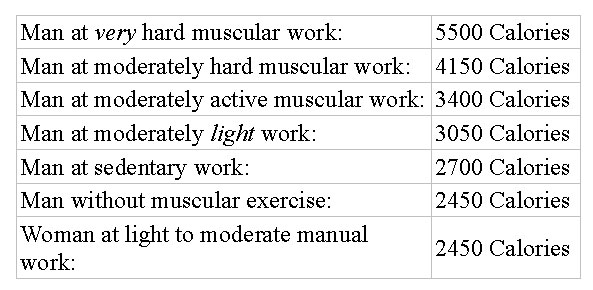 According to the Table of Food Values above, it is evident that chocolate is the most nutritious food we have; also that cocoa, in its powdered state, is the most dangerous of all foods, containing three times as much ash as most of the others, and ten times as much as many. It is a powerful food and also a powerful poison, for it chokes the system more quickly than any other substance.
According to the Table of Food Values above, it is evident that chocolate is the most nutritious food we have; also that cocoa, in its powdered state, is the most dangerous of all foods, containing three times as much ash as most of the others, and ten times as much as many. It is a powerful food and also a powerful poison, for it chokes the system more quickly than any other substance.
Of course, the tables will require some study at first to secure the best nourishment, but it pays in health and longevity and secures the free use of the body, making study and application to higher things possible. After a while the aspirant will become so familiar with the subject that he will need to give it no particular attention.
While the tables show the proportion of chemical substances contained in each article of food named, it must be remembered that not all of this is available for use in the system, because there are certain portions which the body refuses to assimilate.
Of vegetables, we digest only about 83% of the proteids, 90% of the fat, and 95% of the carbohydrates.
Of fruits, we assimilate about 85% of the proteids, 90% of the fat, and 90% of the carbohydrates.
The brain is the coordinating mechanism whereby the movements of the body are controlled and our ideas are expressed. It is built of the same substances as are all other parts of the body, with the addition of phosphorus, which is peculiar to the brain alone.
The logical conclusion is that phosphorus is the particular element by means of which the Ego is able to express thought and influence the dense physical body. It is also a fact that the proportion and variation of this substance is found to correspond to the state and stage of intelligence of the individual. The low-IQers tend to have very little phosphorus; shrewd thinkers have much; and in the animal world, the degree of consciousness and intelligence is in proportion to the amount of phosphorus contained in the brain.
It is therefore of great importance that the aspirant who is to use his body for mental and spiritual work, should supply his brain with the substance necessary for that purpose. Most vegetables and fruits contain a certain amount of phosphorus, but it is a peculiar fact that the greater proportion is contained in the leaves, which are usually thrown away. It is found in considerable quantities in grapes, onions, sage, beans, cloves, pineapples, in the leaves and stalks of many vegetables, and also in sugar-cane juice, but not in refined sugar.
The following table shows the proportions of phosphoric acid in a few articles:
100,000 parts of
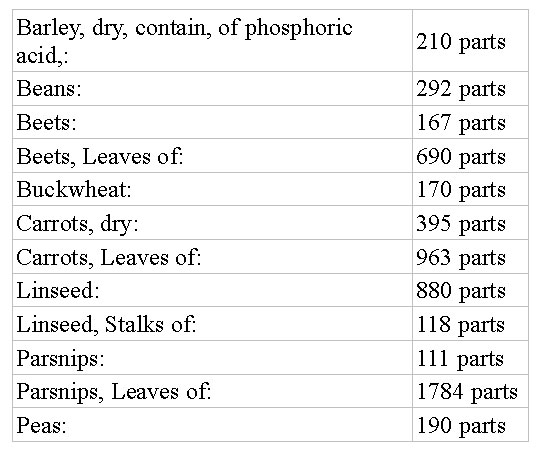
The gist of the preceding argument may be thus succinctly stated:
- The body, throughout the entire period of life, is subject to a process of consolidation.
- This process consists of the depositing by the blood of earthy substances, principally phosphate and carbonate of lime, by which the various parts become ossified, converted into bone, or kindred matter.
- This conversion into bone destroys the flexibility of the vessels, muscles and other parts of the body subject to motion. It thickens the blood and entirely chokes up the minute capillaries, so that the circulation of the fluids and the action of the system generally diminishes, the termination of this process being death.
- This process of consolidation may be retarded and life prolonged by carefully avoiding the foods that contain much ash; by using distilled water for internal purposes; and by promoting excretion through the skin by means of frequent baths.
The foregoing explains why some religions prescribe frequent ablutions as a religious exercise, because they promote the health and purify the dense body. Fasting was also prescribed for the same purpose. They give the stomach a much needed rest, allow the body to eliminate the effete matter, and thus, if not too frequent or too prolonged, promote the health, but usually as much and more can be accomplished by giving the body proper foods which are the best medicines.
Always the first care of the physician is to ascertain if there is proper excretion, that being Nature’s chief means for ridding the body of the poisons contained in all foods.
In conclusion, let the aspirant choose such food as is most easily digested, for the more easily the energy in food is extracted, the longer time will the system have for recuperation before it becomes necessary to replenish the supply. Milk should never be drunk as one may drink a glass of water. Taken in that way, it forms in the stomach a large cheese ball, quite impervious to the action of the gastric juices. It should be sipped, as we sip tea or coffee. It will then form many small globules in the stomach, which are easily assimilated. Properly used, it is one of the best possible articles of diet. Citrus fruits are powerful antiseptics, and cereals, particularly rice, are antitoxins of great efficiency.
Excerpt from The Rosicrucian Cosmo-Conception
Posted in Health, Other Topicswith comments disabled.


